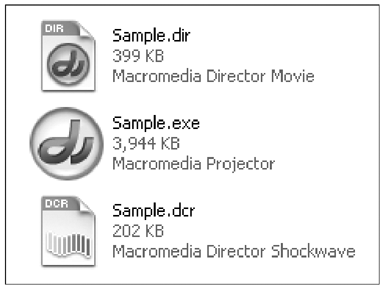| In the previous chapter, you learned how to distribute Director movies by creating a projector. Like Director itself, projectors are self-contained programs that can run on any desktop computer, regardless of what other software is installed. But projectors have a major drawback: Their large file size makes them impractical to distribute over the Internet. Macromedia's response to this problem was to create an alternative distribution method called Shockwave ( Figure 17.1 ). Figure 17.1. From the top: a Director movie, a projector file made from that movie, and a Shockwave file made from the same movie. Note the difference in file sizes.  Technically, Shockwave is just another file format for saving movies created in Director. What's special about Shockwave, however, is that it compresses Director movies down to a very small file size and enables those movies to be played in any Web browser that has the Shockwave Player installed. Also, unlike movies in projectors, Shockwave movies can be streamed ”that is, the user can start watching the beginning of a movie while the rest of the movie continues to download. Because of these features, Shockwave is a great way to add multimedia and interactive capabilities to Web sites. This chapter explains the basics of publishing a Director movie in Shockwave format. You'll learn how to create and organize supporting files, how to set the various browser display options, and how to set Shockwave movies to stream as they download. You'll also find tips for smoothing out streaming over low-bandwidth Internet connections. Flash Talk: Shockwave vs. Flash Director was being used by multimedia developers long before there was a World Wide Web. For years , Director movies were typically distributed on CD-ROM. When the Web began to eclipse CDs as a distribution source of multimedia content, Macromedia invented Shockwave as a way of keeping Director from becoming obsolete. In other words, Shockwave was an afterthought ”a brilliantly designed afterthought, but an afterthought nonetheless. Macromedia Flash came along a few years later, after the Web had already become popular. Though it has some similarities with Director, Flash was specifically designed as a tool for creating Web content. In addition to featuring data-efficient vector graphics, Flash includes specialized tools designed to test and refine streaming (such as the Bandwidth Profiler), which Director lacks. Not surprisingly, then, Flash gradually surpassed Shockwave as the most common multimedia format on the Web. As Flash movies appeared in more and more Web pages, an increasing number of people installed the Flash Player on their computers. Today, about 98 percent of Web users in the United States have some version of the Flash Player installed. By contrast, only about 63 percent have some version of the Shockwave Player installed. It's worth keeping these numbers in mind when you're developing a multimedia or interactive Web site. Naturally, if you want to include features that are unique to Director (such as real-time interactive 3D, described in the next chapter), it makes sense to use Director and Shockwave as your development environment. Similarly, if you plan to distribute your content via a variety of media (such as CD-ROM and the Web), Director has the edge in versatility. But if you're creating content specifically for the Web, it makes sense to ask yourself whether you might better off producing it in Flash rather than Director. | |
